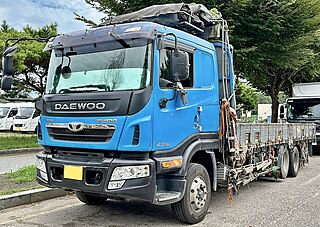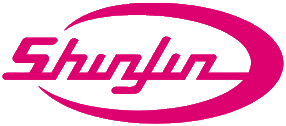
The Hyundai Motor Company, often referred to as Hyundai Motors, and commonly known as Hyundai, is a South Korean multinational automotive manufacturer headquartered in Seoul, South Korea, which was founded in 1967. Currently, the company owns 33.88 percent of Kia Corporation, and fully owns two marques including its luxury cars subsidiary, Genesis, and their electric vehicle brand Ioniq. The three brands altogether make up the Hyundai Motor Group.

A hydrogen vehicle is a vehicle that uses hydrogen to move it. Hydrogen vehicles include some road vehicles, rail vehicles, space rockets, forklifts, ships and aircraft. Motive power is generated by converting the chemical energy of hydrogen to mechanical energy, either by reacting hydrogen with oxygen in a fuel cell to power electric motors or, less commonly, by hydrogen internal combustion.

The Hyundai Motor Group is a South Korean chaebol headquartered in Seoul, South Korea.

The Hyundai Tucson is a compact crossover SUV produced by the South Korean manufacturer Hyundai. It is named after the city of Tucson, Arizona. It was originally known as the Hyundai JM when it was introduced in Japan in 2004.

A fuel cell vehicle (FCV) or fuel cell electric vehicle (FCEV) is an electric vehicle that uses a fuel cell, sometimes in combination with a small battery or supercapacitor, to power its onboard electric motor. Fuel cells in vehicles generate electricity generally using oxygen from the air and compressed hydrogen. Most fuel cell vehicles are classified as zero-emissions vehicles. As compared with internal combustion vehicles, hydrogen vehicles centralize pollutants at the site of the hydrogen production, where hydrogen is typically derived from reformed natural gas. Transporting and storing hydrogen may also create pollutants. Fuel cells have been used in various kinds of vehicles including forklifts, especially in indoor applications where their clean emissions are important to air quality, and in space applications. Fuel cells are being developed and tested in trucks, buses, boats, ships, motorcycles and bicycles, among other kinds of vehicles.

The Hyundai Sonata is a mid-size car that has been manufactured by Hyundai since 1985. The first generation Sonata, which was introduced in 1985, was a facelifted version of the Hyundai Stellar with an engine upgrade, and was withdrawn from the market in two years due to poor customer reaction. While the nameplate was originally only sold in South Korea, the second generation of 1988 was widely exported.

The Hyundai 8 to 25-ton truck (hangul:현대트럭) is a line of heavy-duty commercial vehicles by Hyundai Motor Company. The range was primarily available as cargo and dump truck. Its model truck name is 'Hyundai' and 'Hyundai Mitsubishi Fuso'.

The Mercedes-Benz Actros is a heavy-duty truck introduced by Mercedes-Benz at the 1996 Commercial Vehicle IAA in Hanover, Germany, as the replacement for the SK. It is normally used for long-distance haulage, heavy-duty distribution haulage, and construction haulage. It is powered by an inline-6 diesel engine with a turbocharger and intercooler. Daimler Trucks/Lorries launched version II of the Actros in 2002 and version III in 2007. The fourth generation of the Actros, officially named "the New Actros," launched in July 2011.

The Mitsubishi Fuso Super Great is a heavy-duty commercial vehicle produced by Mitsubishi Fuso, a former division of Mitsubishi Motors. Launched in 1996 to succeed the Mitsubishi Fuso The Great. The range was primarily available in other big-size trucks.

The Hyundai Super truck is a line of heavy-duty commercial vehicle manufactured by Hyundai Motor Company from 1999 or 2001. The range was primarily available in cargo and dump truck. Its model truck name is 'Hyundai', but In USA and Canada market the brand name is 'Bering'.

The Hyundai New Power Truck is a line of heavy-duty commercial vehicle by Hyundai Motor Company. The range was primarily available as cargo and dump truck. Its model truck name is 'Hyundai'.

The Hino Ranger is a medium or heavy duty commercial truck produced by Hino Motors since 1964. In the domestic market, its principal competitors are Isuzu Forward, Nissan Diesel/UD Condor and Mitsubishi Fuso Fighter.

The Hyundai Trago is a line of heavy-duty commercial vehicle by Hyundai Motor Company in luxury commercial vehicle. The range was primarily available as luxury cargo and dump truck, tractor. Its model truck name is 'Hyundai', but in USA and Canada it was known as Bering HD or Bering HDMX, and Korea truck based it was known as Hyundai New Power Truck.

Tata Prima is a range of heavy trucks produced by Tata Motors, a wholly owned subsidiary of Tata & Sons of India. It was first introduced in 2008 as the company's 'global' truck. Tata Prima was the winner of the 'Commercial Vehicle of the Year' at the Apollo Commercial Vehicles Awards, 2010 and 2012. The 'HCV (Cargo) Truck of the Year, 2010' and the 'HCV (Rigid) Truck of the Year, 2012'. First truck range with Common rail engine, Automatic transmission, World-class cabin with HVAC, Air suspension driver seats, Data logger for performance tracking. The trucks have a combined loading capacity of 55 tonnes, ideal for heavy-duty shipment. The interior of the Prima is equipped with modern features like GPS, air conditioning, 4-way adjustable driver and co-driver seats, ADAS features like lane departure warning, driver eye monitoring system etc.

Shinjin Motors or Sinjin Motors is a defunct South Korean car manufacturer.

The Hyundai ix35 FCEV or Tucson FCEV is a hydrogen fuel cell electric vehicle developed by Hyundai. The model is a left-hand drive only conversion to the SUV platform it is based on and was the first of its type to be mass-produced and sold commercially in the world. Different versions are known, the previous version was based on the Hyundai Tucson FCEV, and the upcoming model is based on the current ix35 FCEV. The first generation was introduced in 2001, with the Hyundai Santa Fe FCEV, and had a range of 100 miles (160 km), with a top speed of 78 mph (126 km/h).

Mack Trucks has been selling heavy duty trucks and buses to the United States military since 1911. Virtually every model has been used. The majority have been commercial models designed and built by Mack with their own components, but they have also designed and built military specification tactical trucks. The military vehicles are rated by payload measured in tons.

The Hyundai Nexo is a hydrogen fuel cell powered crossover SUV that was revealed at the 2018 Consumer Electronics Show on January 8, 2018. Replacing the Hyundai Tucson FCEV, the Nexo is the flagship for Hyundai's "eco car" portfolio. The car is named after the Danish city Nexø.

The Genesis GV80 is a mid-size luxury crossover SUV manufactured and marketed by Genesis, Hyundai's luxury division.






















